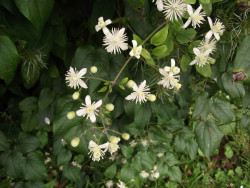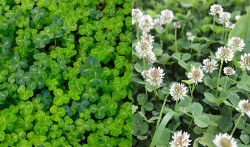NZ’s Worst Garden Weeds & How to Get Rid of Them
Nobody likes weeding, it’s back breaking work that sucks up valuable downtime when you could be doing something you really enjoy. That being said, we all want a garden that at best - looks like a peaceful paradise, and at worst - doesn’t embarrass us if people come over. If that statement struck a chord, you’re not alone. Kiwicare recently undertook some research and found that 60% of Kiwis find gardening a chore and you guessed it…weeds are the main culprit ruining people’s enjoyment of gardening.
Keep on top of weeds and still have a life
The solution is simple, figure out what weeds you’re dealing with and then work smarter not harder.
For example, if you’re dealing grass or broad leaf weeds along your driveway, paths or fence lines, just treat them with Weed Weapon Long Term. This clever product prevents plants from growing back for up to for up to 365 days! There’s no need to get on your hands and knees to manually pull them out every few weeks. And using regular weed killers/herbicides every 2 – 3 months can start to get seriously expensive. Not to mention it sucks up a lot of time too. Weed Weapon Long Term is the only long-acting product in the market, and it can save you so much time and hassle.
Then there’s your other weeds. A lot of the time knowing how best to tackle them is a bit of a dark art. So, take a look at the table below, find the weed you’re dealing with and then win back your weekends. Here’s a top tip, if you’re dealing with a number of weeds on the list, take a good look at the products recommended in the solutions column. You may only need to buy 1 product that can treat them all – Now that’s a win.
If you’re trying to find out how to deal with Lawn Weeds, take a look at our list of the Top 20 Worst Lawn Weeds instead.
NOTE: This article is best viewed in landscape mode on your phone, or on a larger screen like a tablet, laptop or desktop computer in order to see all three columns in the table properly.
NZ's 20 Worst Garden Weeds
Weed | Harm caused | Best Product(s) for the Job |
Perennial climber/scrambler that strangles and shades out desirable plants. Waxy leaves, multiple root systems and large size when established can make ivy difficult to control. | Cut back the plant leaving approximately 20 leaves at the bottom close to the roots. Paint Weed Weapon Invade Gel on the upper and lower surfaces of the leaves and onto the cut ends. OR ApplyWeed Weapon WoodyWeeds or Extra Strength mixed with Dye & Stick to all foliage of the ivy, it is important not to miss any sections. Further application may be necessary for extensive mature ivy. | |
| Coarse Grasses like Couch/twitch, Poa annua, Kikuyu, Paspalum, etc. | Annual and perennial grasses seed readily infest Annual and perennial grasses seed readily often infest garden beds, paths and waste places. Can be difficult to control. | Wearing rubber gloves paint Weed Weapon Invade Gel onto the crown of the weed grass (central growing region) and as many leaves of the weed grass as possible. This will kill the grass and its roots. Specialist lawn weed-killing products won’t work as they’re designed not to kill grass. |
Rapidly growing smothering vines. Can be difficult to spray when twined in desirable plants. | Using Weed Weapon Invade Gel if worried about surrounding/intertwined plants. You may want to cut the weed back leaving only a few (at least 20) leaves at the bottom close to the roots. Paint as many leaves as possible on both the upper and lower surfaces. It's best to apply the gel immediately after cutting (within 15 seconds) – so cut apply gel, cut apply gel etc. OR Cut vines at waist height (in summer-autumn) and spray foliage below with Weed Weapon Extra Strength – for best results to ensure full coverage. Follow up 2 weeks later to check that slashed stems have not re-sprouted, if they have then re-treat the plant. | |
Perennial spreads easily to beds and pots. Bulbed forms can re-sprout making it difficult to control | Use Weed Weapon Extra Strength, Weed Weapon Rapid Action or Weed Weapon Invade Gel to kill off the top growth of oxalis. Then once clear apply Weed Weapon Preventer granules to prevent regrowth from bulbils, this is very effective on oxalis. Do not disturb soil for a period of 6 months. If soil is disturbed re-apply the Weed Weapon Preventer. Note: seeds will not grow in the treated area, but plants can be planted in the area. | |
Rapidly growing scrambling climber smothers desirable plants. Waxy leaves, multiple root systems and large size when established can make control difficult. | Apply Weed Weapon Rapid Action, or Weed Weapon Extra Strength concentrate with Dye & Stick. Follow up on re-sprouting areas twice a year. OR For long-term control on non-cultivated areas use Weed Weapon Long Term. OR Cut down periwinkle and immediately apply Weed Weapon Invade Gel to all cut ends to kill root systems effectively. Dispose of plant material at a refuse transfer station or burn. Check for regrowth. | |
Rapidly growing smothering vine. Can be difficult to spray when twined in desirable plants. | Using Weed Weapon Invade Gel if worried about surrounding/intertwined plants. You may want to cut the weed back leaving only a few (at least 20) leaves at the bottom close to the roots. Paint as many leaves as possible on both the upper and lower surfaces. It's best to apply the gel immediately after cutting (within 15 seconds) – so cut apply gel, cut apply gel etc. OR Cut vines at waist height (in summer-autumn) and spray foliage below with Weed Weapon Extra Strength – for best results ensure full coverage. Follow up 2 weeks later to check that slashed stems have not re-sprouted, if they have then re-treat the plant. | |
Group of, often prickly, annual-perennial rosette weeds with taproots. Most are relatively easy to control. | Knockdown weeds quickly with Weed Weapon Extra Strength, Weed Weapon Rapid Action or Weed Weapon Woody Weeds. It is biodegradable in the soil so planting can be carried out 7 days after treatment. For a fast-acting organic solution on young thistles use Weed Weapon Natural Power. | |
Perennial spreading ground cover. Water-repellent leaves and large size when established can be difficult. | This weed can be difficult to control because it usually takes 2-3 treatments to kill it fully and it readily sprouts from any live and dropped vegetative material. It does not set seed in NZ but spreads readily. Click on the weed’s name or image to see full details on how to treat it. | |
Perennial bulbed weed. Waxy leaves and bulbs can make it hard to control. | Where the onion weed is apart from desirable plants spray with Kiwicare Weed Weapon Extra Strength with Dye & Stick. OR LawnPro Turfclean will kill onion weed between native grasses without harming the grass. As with all such bulbous plants a second treatment may be necessary. OR Spot treat by painting the centre of the onion weed with Weed Weapon Invade Gel | |
Prickly, scrambling woody perennial. Mature plants can be difficult to control. | Spray in summer-autumn, before leaves become brittle with Weed Weapon Woody Weeds or Weed Weapon Extra Strength with Dye & Stick ensuring complete coverage. OR Cut down and paint stumps with Weed Weapon Invade Gel. | |
| Spray with Weed Weapon Extra Strength (plus Dye & Stick) or Weed Weapon Rapid Action. Ensure all parts of each plant are treated and all plants in the colony. OR Cut down the agapanthus plants and immediately paint the stump with a thick layer of Weed Weapon Invade Gel. | |
| In flower beds and waste areas - Spot treat with Weed Weapon Extra Strength or Rapid Action. Weed Weapon is systemic and kills weeds down to the roots within 2-4 days and is an ideal product for use around established trees and shrubs. It is inactive in the soil so planting can be safely carried out soon after treatment. For a fast acting organic solution use Weed Weapon Natural Power.
| |
Perennial with large taproot readily grows in turf areas and garden beds. Moderately difficult to control once established. | In flower beds and waste areas - Spot treat with Weed Weapon Extra Strength or Rapid Action. Weed Weapon is systemic and kills weeds down to the roots within 2-4 days and is an ideal product for use around established trees and shrubs. It is inactive in the soil so planting can be safely carried out soon after treatment. For a fast acting organic solution use Weed Weapon Natural Power. | |
| Use Weed Weapon Extra Strength or Rapid Action to kill off the top growth. OR for a fast acting organic solution use Kiwicare Weed Weapon Natural Power. | |
| Bamboo is particularly tough to get rid of. Click on the weed name or image to see the step by step guide to getting rid of it. | |
| Spot treat with Weed Weapon Extra Strength, Rapid Action or Weed Weapon Natural Power. | |
| Cleavers (aka sticky willow, bedstraw, goosegrass, robin-run-the-hedge etc) |
| Use Kiwicare Weed Weapon Extra Strength or Rapid Action. OR In organic gardens Weed Weapon Natural Power will effectively kill cleavers. To prevent germination of seed and growth of bulbs use Weed Weapon Long Term or Weed Weapon Preventer can be used in areas once weeds have been cleared. |
Shrubby perennials that are poisonous but relatively easy to control. | Spray (summer-autumn, before leaves become brittle) with Weed Weapon Extra Strength, Rapid Action or LawnPro Prickle and Hydrocotyle with Dye & Stick ensuring complete coverage. OR Cut down and paint stumps with Weed Weapon Invade Gel. | |
Large leafy plant spreads and shades out desirable plants. Large root systems can make control difficult. | Apply Weed Weapon Rapid Action ready to use, or Weed Weapon Extra Strength concentrate with Dye & Stick, all year round. Follow up on re-sprouting areas twice a year. OR Cut down bears breeches and immediately apply Weed Weapon Invade Gel to all cut ends to kill root systems effectively.
| |
Rapidly growing spring annual. Relatively easy to control. | To control seedlings in garden beds, spot treat with Weed Weapon Extra Strength, Weed Weapon Rapid Action or Weed Weapon Natural Power. OR To control larger mature fathen spray the whole plant with Weed Weapon Extra Strength concentrate with Dye & Stick. |
Looking for a long term solution?
If you're looking for a longer term solution, Weed Weapon Long Term could be the right product for you. It kills the plants it has been sprayed on and then stays active in the soil (or surface e.g. driveway), helping to prevent plants from growing back for up to 365 days (depending on conditions). Weed Weapon Long Term is NOT a selective herbicide. This means that it will kill any and all plants it has contact with, or that are on/in the affected soil or surface. As a result, we do not recommend using it in places you are actively trying to grow plants (e.g. garden beds), or planning to grow plants in the next 12 months.
Keep the weeds away
Once you’ve gotten your garden nice weed free, you might want to consider using a product like Weed Weapon Preventer. Sprinkle it across the ground around well-established shrubs and trees, and it’ll stop new plants (most commonly weeds) breaking through for several months. We’re all about working smarter here at Kiwicare.
What is Dye & Stick?
You may have seen this name pop up a number of times in the list. Kiwicare’s Dye & Stick is a product that you can mix with herbicide concentrates to improve performance and show where spray has landed, so that complete coverage can be achieved. This means there will be no missed spots, or wasteful double handling. It also helps the herbicide spread better (reducing the amount of herbicide needed) and to stick to the leaves of a plant better making the herbicide more effective. If you’re dealing with tough weeds that have waxy leaves like ivy or agapanthus, we highly recommend mixing your weed killer with Dye & Stick to improve your likelihood of success. Note: There is no need to use Dye & Stick with products like Weed Weapon Invade Gel as the coloured, thick gel like herbicide does not require it. We also do not recommend mixing it with ready to use sprays.
Is your weed not on the list?
That’s OK there’s a good chance our website still has the answers you need – your troublesome weeds just didn’t make it into the top 20 list.
- If you know what your weed is called – Hit the search button in our menu, type in the name of your weed and hit enter.
- If you know what it looks like but not the name or just need a bit more help with identification - Scroll the top of the page and click on the yellow Problem Solver band, plug in your details and the tool will help you find out what you’re dealing with and how to control it.
 Ivy
Ivy


 Periwinkle
Periwinkle














